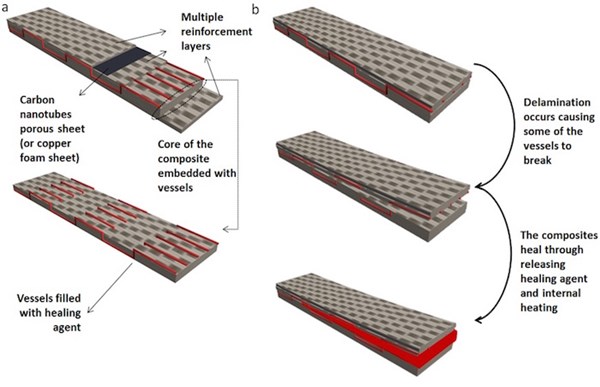New research on self-healing composites
Researchers have developed a method of allowing composites to self-heal cracks at temperatures well below freezing.
Researchers at the University of Birmingham (UK) and Harbin Institute of Technology (China) say they have developed a method of allowing composites to self-heal cracks at temperatures well below freezing. The paper, published in Royal Society Open Science, is reportedly the first to show that self-healing materials can be manipulated to operate at very low temperatures (-60°C).
The team stated that it could be applied to fiber-reinforced materials used in situations where repair or replacement is challenging such as offshore wind turbines, or even “impossible”such as aircraft and satellites during flight.
Self-healing composites have been able to restore their properties automatically and in favorable conditions, composites have shown impressive healing capability. But the researchers claim that until this paper, healing was deemed insufficient in adverse conditions, such as very low temperature.
Similarly to how some animals in the natural world maintain a constant body temperature to keep enzymes active, the new structural composite maintains its core temperature. According to researchers, 3D hollow vessels, with the purpose of delivering and releasing the healing agents, and a porous conductive element, to provide internal heating and to defrost where needed, are embedded in the composite.
Yongjing Wang, PhD student at the University of Birmingham, explained, “Both of the elements are essential. Without the heating element, the liquid would be frozen at -60°C and the chemical reaction cannot be triggered. Without the vessels, the healing liquid cannot be automatically delivered to the cracks.”
A healing efficiency of over 100% at temperatures of -60°C was obtained in a glass fiber-reinforced laminate, but the technique could be applied across a majority of self-healing composites. Tests were run using a copper foam sheet or a carbon nanotube sheet as the conductive layer. The latter of the two was able to self-heal more effectively with an average recovery of 107.7% in fracture energy and 96.22% in peak load.
The healed fiber-reinforced composite, or host material, would therefore have higher interlaminar properties – that is the bonding quality between layers. The higher those properties, the less likely it is that cracks will occur in the future.
Wang added, “Fiber-reinforced composites are popular due to them being both strong and lightweight, ideal for aircraft or satellites, but the risk of internal micro-cracks can cause catastrophic failure. These cracks are not only hard to detect, but also to repair, hence the need for the ability to self-heal.”
The group will now look to eliminate the negative effects that heating elements have on peak load by using a more advanced heating layer. Their ultimate goal, however, is to develop new healing mechanisms for more composites that can recover effectively regardless the size of faults in any condition.

Photo credit: University of Birmingham.
Related Content
-
Resins, additives, adhesives and 3D printing solutions
CAMX 2023: Arkema’s broad portfolio of products for composites fabricators aim to enhance performance, durability and sustainability.
-
Henkel releases digital tool for end-to-end product transparency
Quick and comprehensive carbon footprint reporting for about 58,000 of Henkel’s adhesives, sealants and functional coatings has been certified by TÜV Rheinland.
-
Belzona composite wrap restores corroded carbon steel pipeline
Two-part epoxy paste, epoxy structural adhesive, composite wrap and anti-corrosion coating prevent environmental and economic loss for customer.












.jpg;maxWidth=300;quality=90)


